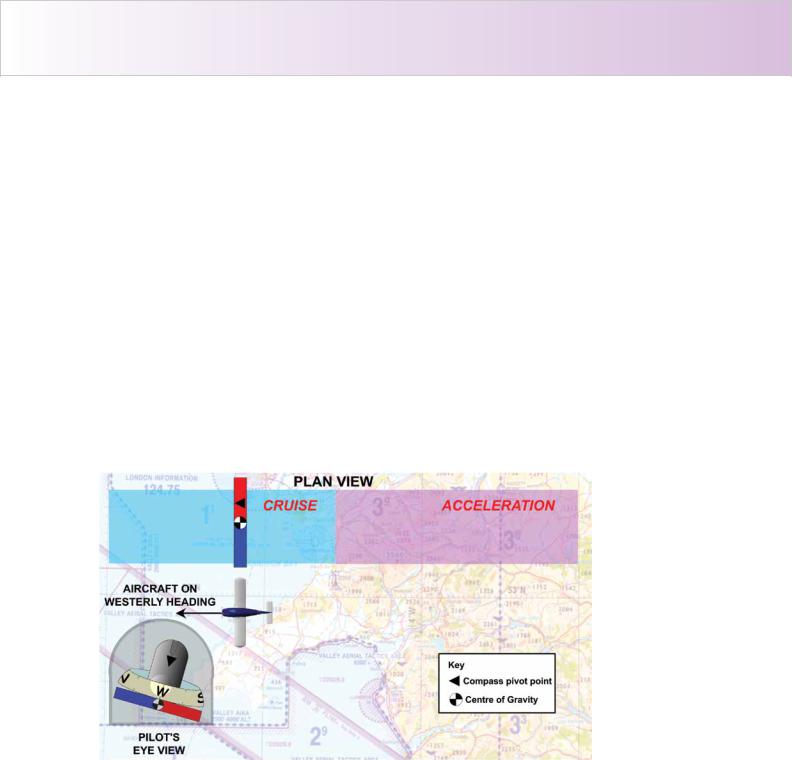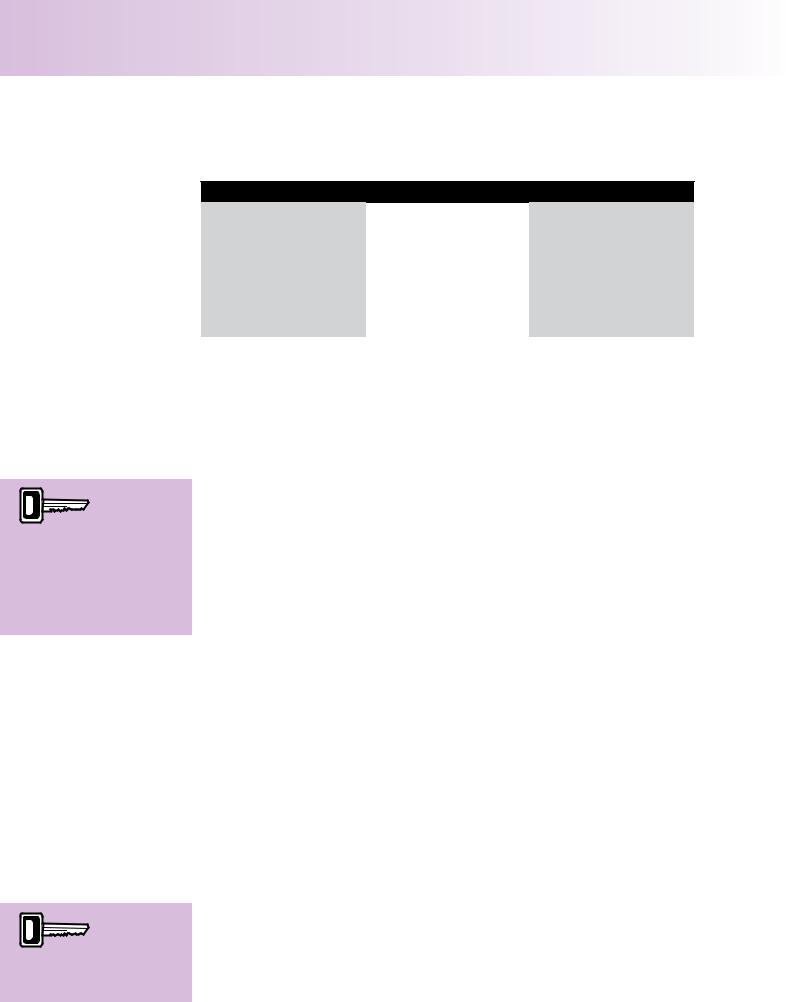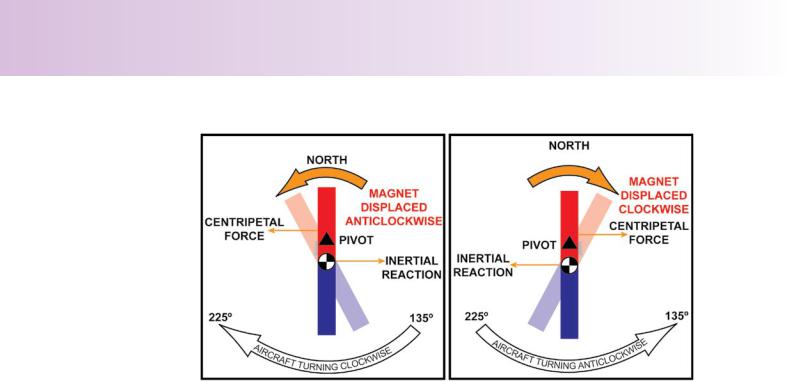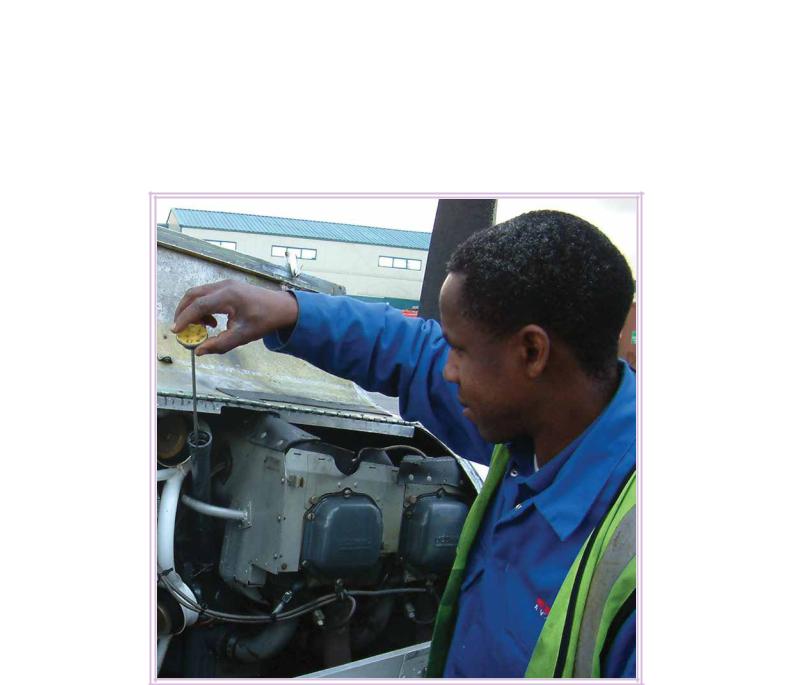
ppl_06_e2
.pdf
ID: 3658
Customer: Oleg Ostapenko E-mail: ostapenko2002@yahoo.com
Customer: Oleg Ostapenko E-mail: ostapenko2002@yahoo.com
CH AP T ER 1 5 : G Y R O SCO P IC INST R U MENT S & T H E MA
acceleration force acts on the magnet’s centre of gravity, and the compass reading is again steady and correct.
Ac c e l e r a t i n g W e s t .
Figure 15.27 shows both a plan view and a pilot’s eye view of a pendulously suspended magnet (with residual dip) in the Northern Hemisphere with the aircraft accelerating on a westerly heading. Note that the pivot point and the magnet’s centre of gravity do not lie on the same vertical line. The magnet is dipping towards the nearer pole: Magnetic North in this case.
The magnet is attached to the aircraft at the pivot point. When the pivot is being accelerated, the magnet will lag behind because of its inertia. The inertial force acts at the magnet’s centre of gravity. The result will be that, even though the aircraft is flying in a straight line, the magnet will rotate (in this case anticlockwise) indicating a turn towards North.
Cr u i s e P h a s e ( W e s t e r l y H e a d i n g ) .
When the aircraft is in cruising flight, there is no acceleration; the magnet, therefore, moves back to its original position on a Westerly heading, and once more indicates the correct reading. This situation is illustrated in Figure 15.28.
Figure 15.28 The compass reading is again correct.
De c e l e r a t i o n ( W e s t e r l y H e a d i n g ) .
If the aircraft decelerates while maintaining a Westerly heading, the pendulous magnet assembly will move ahead of the compass pivot, inducing the compass to indicate an apparent turn towards the South.
Ac c e l e r a t i o n s a n d De c e l e r a t i o n s o n Ea s t e r l y H e a
By analogous reasoning, an acceleration and deceleration on an Easterly heading will, likewise, cause the compass to indicate an apparent turn towards North and South, respectively. Acceleration errors on Easterly headings are therefore identical to those on Westerly headings. During cruising flight at constant airspeed, the compass will read correctly.
243

Order: 6026
Customer: Oleg Ostapenko E-mail: ostapenko2002@yahoo.com
Customer: Oleg Ostapenko E-mail: ostapenko2002@yahoo.com
CH AP T ER 1 5 : G Y R O SCO P IC INST R U MENT S & T H E MAG NET IC CO
The table below summarises the acceleration errors of the magnetic compass in the
Northern Hemisphere.
When referring to
the magnetic compass,
pilots must bear in mind that turning errors are maximum when turning through north and south, and minimum when turning through east and west.
When turning through North in the Northern
Hemisphere, liquid swirl will increase the magnitude of any turning error.
LINEAR ACCELERATION ERRORS
Heading |
Acceleration |
Deceleration |
Northerly |
No Error |
No Error |
Southerly |
No Error |
No Error |
Easterly |
Indicates apparent turn |
Indicates apparent turn |
|
North |
South |
Westerly |
Indicates apparent turn |
Indicates apparent turn |
|
North |
South |
Figure 15.29 Table of linear acceleration errors in the magnetic compass.
Acceleration Errors on Easterly and Westerly Headings in the Northern Hemisphere can be memorised by using the mnemonic ANDS: Acceleration North, Deceleration South. In the Southern Hemisphere, compass acceleration errors are the opposite to those shown in the table. Remember, there are no linear acceleration errors on Northerly and Southerly Headings.
T u r n i n g Er r o r s .
A turning error in a compass indication is a specialised type of acceleration error. When an aircraft turns at a constant speed it is subject to centripetal acceleration towards the centre of the turn. This acceleration, which is a result of the aircraft continuously changing direction, is caused by the centripetal force generated by the banked wings of the aircraft. The centripetal force acts on all parts of the aircraft, including the centre of gravity of the compass magnets and on the magnet pivot points. This situation leads to the magnetic compass displaying indication errors during turns.
Turning errors are maximum when turning through North and South, and, ignoring liquid swirl, zero when turning through East and West. The basic theory of turning errors is much the same as that for the linear acceleration errors that we have just covered.
Away from the regions of the magnetic equator, due to the effect of magnetic dip, the compass’s centre of gravity will be displaced from a position directly beneath the pivot point. In a turn, the aircraft accelerates towards the centre of the turn, and therefore an acceleration force acts through the pivot towards the centre of the turn, while the inertial reaction force acts outwards through the centre of gravity. This situation results in the magnet assembly tending to ‘swing out’ from the turn, rotating the magnet assembly around the pivot point and producing a turning error.
Turning errors are usually more significant than linear acceleration errors for two reasons. Firstly, because they are inherently of greater magnitude, resulting from the greater displacement of the magnet assembly in turns; and secondly, turns are likely to be more prolonged than linear accelerations.
Li q u i d Sw i r l .
During a turn, the liquid in contact with the inside of the compass bowl tends to be dragged around with the bowl, so producing small eddies in the liquid which drift inwards from the circumference and deflect the magnet assembly in the direction of the turn. Therefore the liquid tends to swirl - and rotate the magnet assembly with it - in the same direction as the aircraft’s turn.
244

ID: 3658
Customer: Oleg Ostapenko E-mail: ostapenko2002@yahoo.com
Customer: Oleg Ostapenko E-mail: ostapenko2002@yahoo.com
CH AP T ER 1 5 : G Y R O SCO P IC INST R U MENT S & T H E MA
When turning through North in the Northern Hemisphere, liquid swirl will increase the magnitude of any turning error (in which the assembly turns in the same direction as the aircraft).
The size of the turning error when turning through South in the Northern Hemisphere (where the assembly turns in the opposite direction to the aircraft) will be reduced. In the Southern Hemisphere, the swirl effect will be in the opposite sense.
Note that at the Magnetic Equator where there is no magnetic dip, liquid swirl is the sole source of turning error; with most compasses this effect is only slight.
T u r n i n g t h r o u g h No r t h , So u t h , Ea s t a n d W e s t .
Turning errors are maximum when turning through Magnetic North or South, decreasing to zero when passing through East or West.
Turning error increases with increase in magnetic latitude. At the Magnetic Equator the only turning error is due to liquid swirl.
Whenever the pilot turns through the nearer pole (that is the North Pole in the Northern Hemisphere, or the South Pole in the Southern Hemisphere) the aircraft and compass magnet rotate in the same direction. In this situation, the relative movement between the compass card (attached to the magnet) and the compass housing will be small, and the compass card will appear to react sluggishly. Therefore, the pilot must roll out of the turn early, just before the indicated heading is reached (see Figures 15.30 and 15.31).
Figure 15.30 Turning from 045º to 315º |
Figure 15.31 Turning from 315º to 045º |
(Northern Hemisphere). |
(Northern Hemisphere). |
Whenever the pilot turns through the further pole (that is the South Pole in the Northern Hemisphere, or the North Pole in the Southern Hemisphere) the aircraft and the compass rotate in opposite directions. In this situation, the relative movement between the compass card and the compass housing will be large and the compass card will react in a lively manner. Therefore, the pilot must roll out of the turn just after the indicated heading is reached (see Figures 15.32 and 15.33 overleaf).
245

Order: 6026
Customer: Oleg Ostapenko E-mail: ostapenko2002@yahoo.com
Customer: Oleg Ostapenko E-mail: ostapenko2002@yahoo.com
CH AP T ER 1 5 : G Y R O SCO P IC INST R U MENT S & T H E MAG NET IC CO
Figure 15.32 Turning from 135º to 225º |
Figure 15.33 Turning from 135º to 225º |
(Northern Hemisphere). |
(Northern Hemisphere). |
In the Northern Hemisphere, when rolling out of a turn onto a magnetic heading, using a direct indicating magnetic compass, the pilot should memorise the mnemonic NESL (NORTH (rollout) EARLY, SOUTH (rollout) LATE).
SYNCHRONISING DIRECTION INDICATOR AND MAGNETIC
COMPASS.
Having learned about the indication errors to which the magnetic compass is susceptible, you are now in a position to appreciate why the aircraft must be flown at a constant speed, with wings level, whenever the Direction Indicator is to be synchronised with the Magnetic Compass.
COMPASS SERVICEABILITY CHECKS.
Prior to take off, the following checks of the Magnetic Compass should be carried out. The checks are done before engine start, during taxying or after lining up on a runway, as appropriate.
P r i o r t o En g i n e St a r t .
Check that there is no obvious damage to the compass body or glass, such as dents or cracks, and that the compass is securely mounted.
Check that the compass liquid is free from sediment and discolouration, either of which would indicate corrosion, resulting in increased pivot friction.
The compass liquid should also be free from bubbles, which would probably indicate a leaking seal. Turbulence and manoeuvres would cause any bubbles to move about, creating eddies which could disturb the magnet system.
The compass reading can also be checked for gross errors when you first enter the aircraft by verifying that the compass is giving a sensible reading.
246

ID: 3658
Customer: Oleg Ostapenko E-mail: ostapenko2002@yahoo.com
Customer: Oleg Ostapenko E-mail: ostapenko2002@yahoo.com
CH AP T ER 1 5 : G Y R O SCO P IC INST R U MENT S & T H E MA
Du r i n g T a x y i n g .
Check the compass reading while taxying the aircraft. The compass readings should decrease when turning left, and increase when the aircraft is turning right.
Af t e r l i n i n g u p .
Just before take-off, check the compass reading against the runway heading.
247

Order: 6026
Customer: Oleg Ostapenko E-mail: ostapenko2002@yahoo.com
Customer: Oleg Ostapenko E-mail: ostapenko2002@yahoo.com
CH AP
AP T ER
T ER  1 5 :
1 5 : G
G Y R O
Y R O  SCO P IC INST R U
SCO P IC INST R U MENT S &
MENT S & T H
T H E MAG NET IC CO
E MAG NET IC CO
R e p r e s e n t a t i v e P P L - t y p e q u e s t i o n s k n o w l e d g e o f G y r o s c o p i c In s t r u m e n Co m p a s s .
1.What is the purpose of the ball in the Turn and Slip Indicator or Turn Coordinator?
a.The ball indicates rate of turn
b.The ball indicates angle of bank
c.The ball indicates slip and skid
d.The ball indicates rate of descent in a turn
2.A magnetic heading:
a.is the sum of the true heading, and magnetic deviation
b.is the sum of the magnetic deviation and the magnetic variation
c.is always referenced to true north
d.is the sum of the compass reading and compass deviation
3.If the variation is west of true north:
a.add it to the desired true track to get the correct magnetic heading
b.add it to your aircraft’s magnetic heading to get the desired true track
c.subtract it from the desired true track to get the correct magnetic heading
d.the angle of dip will be greatest
4.The turning errors of the magnetic compass are such that :
a.They are zero when turning through North and South
b.They are maximum when turning through North and South, requiring the pilot to roll out on heading early when turning through the nearer pole and late when turning through the further pole
c.They are maximum when turning through East and West
d.They are maximum when turning through North and South, requiring the pilot to roll out on heading early when turning through the further pole and late when turning through the nearer pole.
5.The gyroscope in an artificial horizon is:
a.an Earth gyroscope rotating in a vertical plane about the aircraft’s lateral axis
b.an Earth gyroscope rotating in a horizontal plane about a vertical spin axis
c.an Earth gyroscope rotating in a vertical plane about the aircraft’s longitudinal axis
d.a tied gyroscope rotating in a horizontal plane about the aircraft’s longitudinal axis
248

ID: 3658
Customer: Oleg Ostapenko E-mail: ostapenko2002@yahoo.com
Customer: Oleg Ostapenko E-mail: ostapenko2002@yahoo.com
CH AP
AP T ER
T ER  1 5 :
1 5 : G
G Y R O
Y R O  SCO P IC INST R U
SCO P IC INST R U MENT S &
MENT S & T H
T H E MAG NET IC C
E MAG NET IC C
6.The rigidity in space of a gyro:
a.keeps its axis pointing in a fixed direction in space unless it is acted on by an external force
b.is decreased by manufacturing the rotor from brass
c.is maximum at the magnetic equator
d.is minimum at the magnetic equator
7.A Direction Indicator should be aligned with the magnetic compass; approximately every 15 minutes:
a.to minimise the effect of magnetic dip
b.to offset the affect of acceleration during a turn
c.because of the effect of liquid swirl
d.in order to compensate for precession and apparent wander, by using the caging knob to rotate the DI azimuth card when the wings are level and the aircraft is in unaccelerated flight
8.A Direction Indicator:
a.is badly affected by acceleration in a turn
b.suffers from apparent drift of the gyroscope from the fixed position in space to which it was aligned, produced by earth rotation
c.is not affected by drift produced from mechanical friction in the gyroscope gimbal bearings
d.provides a stable reference in elevation in order to indicate accurate pitch attitudes
9.The purpose of the compass deviation card is to:
a.compensate for the influence of non-ferrous material carried on the person of the pilot and/or passengers
b.indicate the discrepancy between the heading shown on the compass and the actual magnetic heading
c.indicate the discrepancy between the aircraft’s track and magnetic north
d.indicate the discrepancy between the aircraft’s track and true north
10.When referring to the magnetic compass, pilots must bear in mind that:
a.turning errors are maximum when turning through north and south, and minimum when turning through east and west
b.turning errors are maximum when turning through east and west, and minimum when turning through north and south
c.turning errors increase, the nearer the aircraft is to the magnetic equator, and diminish as the aircraft approaches the magnetic poles
d.acceleration errors decrease the nearer the aircraft is to the magnetic poles, and increase as the aircraft approaches the magnetic equator
249

Order: 6026
Customer: Oleg Ostapenko E-mail: ostapenko2002@yahoo.com
Customer: Oleg Ostapenko E-mail: ostapenko2002@yahoo.com
CH AP
AP T ER
T ER  1 5 :
1 5 : G
G Y R O
Y R O  SCO P IC INST R U
SCO P IC INST R U MENT S &
MENT S & T H
T H E MAG NET IC CO
E MAG NET IC CO
11.If the gyroscope of a turn indicator runs at a lower RPM than its design specification, how will the actual rate of turn of the aircraft compare to the rate of turn shown on the turn indicator?
a.the actual rate of turn of the aircraft will be same as the rate indicated
b.the actual rate of turn of the aircraft will be less than the rate indicated
c.the turn indicator will not indicate a rate of turn
d.the actual rate of turn of the aircraft will be greater than the rate indicated
12.When a compass swing is being carried out:
a.the location of the aircraft must coincide with a suitable isogonal
b.it will enable the aircraft’s variation to be determined
c.the aircraft’s heading compass reading is compared with readings from a highly accurate ‘land’ or ‘datum’ compass
d.the whole aircraft must be electrically dead
13.If there are metallic objects close to an aircraft’s magnetic compass:
a.they should have no effect on compass indications
b.they will have a significant effect on magnetic variation
c.the Direction Indicator will not be able to be synchronised with the compass
d.they will cause errors in the indications of the compass
Question |
1 |
2 |
3 |
4 |
5 |
6 |
7 |
8 |
9 |
10 |
11 |
12 |
|
Answer |
|
|
|
|
|
|
|
|
|
|
|
|
|
|
|
|
|
|
|
|
|
|
|
|
|
|
|
Question |
13 |
|
|
|
|
|
|
|
|
|
|
|
|
Answer |
|
|
|
|
|
|
|
|
|
|
|
|
|
T h e a n s w e r s t o t h e s e q u e s t i o n s c a n b e f o
250

Customer: Oleg Ostapenko E-mail: ostapenko2002@yahoo.com
CHAPTER 16
AIRWORTHINESS
251

Order: 6026
Customer: Oleg Ostapenko E-mail: ostapenko2002@yahoo.com
Customer: Oleg Ostapenko E-mail: ostapenko2002@yahoo.com
CH AP T ER 1 6 : AIR W O R T H INESS
252
